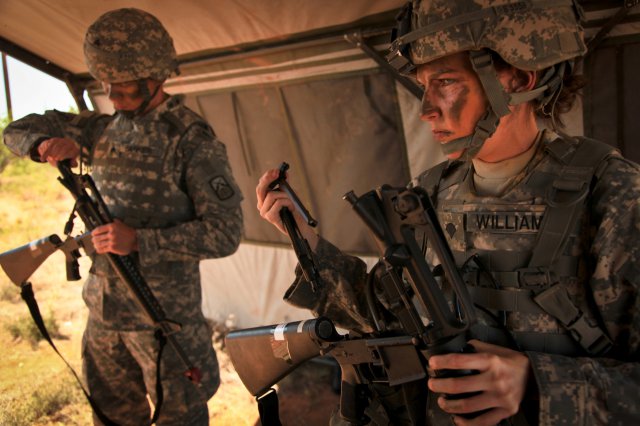
By JD Leipold
WASHINGTON (Army News Service, July 19, 2012) — Today, both male and female Soldiers wear body armor that has been designed for men. But the Army plans to field to women next summer a new type of body armor, designed for them, that will be shorter in the torso with more customized adjustments specific to the female form.
Until that happens, the 14 percent of the Army who are women will continue to wear one of the 11 sizes of the Improved Outer Tactical Vest, or IOTV, that are worn by their male counterparts.
Following anthropomorphic sizing and fitting studies overseas, and also at Fort Bragg, N.C., West Point, N.Y., and Fort Campbell, Ky., between 2009 and 2011, Program Executive Office, or PEO, Soldier started developing female body armor prototypes that addressed the physical differences between the sexes.
Lt. Col. Frank J. Lozano, the product manager for Soldier Protective Equipment, said one thing his shop realized quickly from the studies was that women generally have narrower shoulders than males. The shoulder area on the new IOTV design was brought in closer to the neck by adding more fabric and opening the area around the armpits.
The change translates to increased range of motion in the shoulders and upper arms and also allows weapons to be seated in the shoulder weld. The extra material and adjustment straps also allows darting to be incorporated much as it is on a woman’s blouse which will give a more secure and customized fit.
“Most females tend to have a narrow or thinner waist as it relates to the chest area, so we pulled the waist area in,” Lozano said, adding that it’s not always a one-to-one relationship. “Some women will want more room in the waist area so we allowed for adjustability in the cummerbund in the back which can be pulled in tighter or let out more than on the standard IOTV.”
PEO Soldier also realized through its multiple studies that the typical torso length for women was for the most part shorter than that of men. The female IOTV will be shorter at the bottom. Lozano said the new design will keep the IOTV from rubbing on the hips, which can cause chafing while walking.
Female Soldiers had also advised PEO Soldier that the standard IOTV, with its longer torso, causes the front armor plate to press into their thighs when they are seated. This cuts off blood flow to their legs. The female version of the IOTV, with its shortened torso, will address this issue. Additionally, a new exterior plate pocket will allow the armor plate to be inserted from the side in a more diagonal fashion.
Though not part of the female version of the IOTV design, the Army is also looking for ways to develop armor plating that better conforms to the human body.
“The challenge right now is that when you bring in those complex curvatures, the plate loses some of its strength,” Lozano said. “We’re working with some armor manufacturers to invest in a manufacturing capability that finds the right chemistry to develop the soft and hard armor necessary to have a complex curved plate at a light weight that still defeats the threats.”
Developments in protective plate design will make ballistic protection more comfortable and form-fitting for both female and male Soldiers, but that’s a way off.
Lozano said in the September-October time frame PEO Soldier will begin fielding 100 prototypes to female engagement teams from the 101st Airborne Division to evaluate.
“There are 30 females who we’ll provide with spares and repair parts,” he said. “We’ll hold some in reserve in case other females get added to the teams. They’ll do user evaluations, then provide feedback to us that we’ll wrap into the final iteration of the design and look to field to a brigade combat team by next summer.”
In celebration of the 25th anniversary of the Army Acquisition Corps (AAC), Access is publishing articles that highlight milestones throughout the history of the AAC. Each article marks a moment in acquisition excellence.
This article was published on Army.mil, July 19, 2012.








